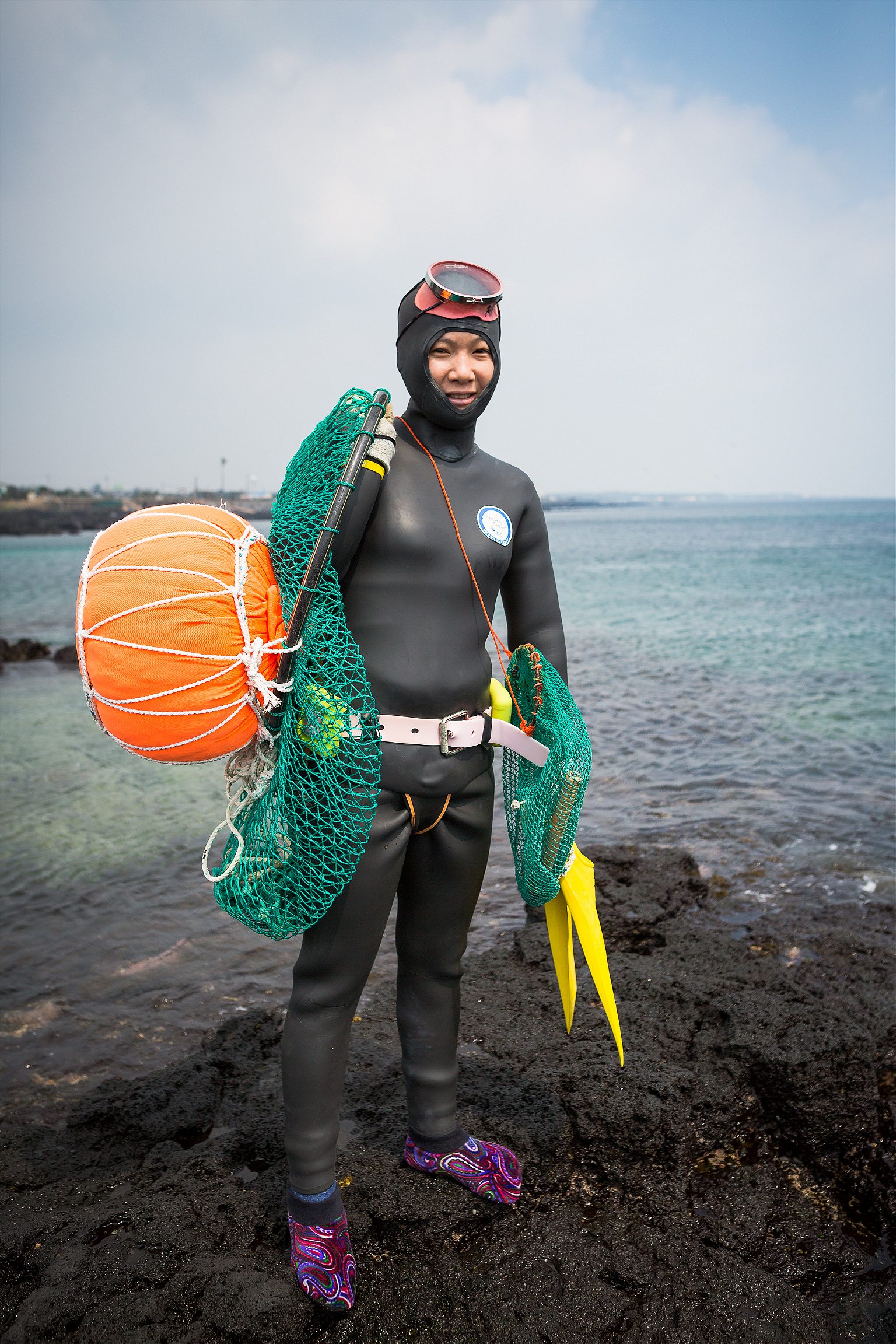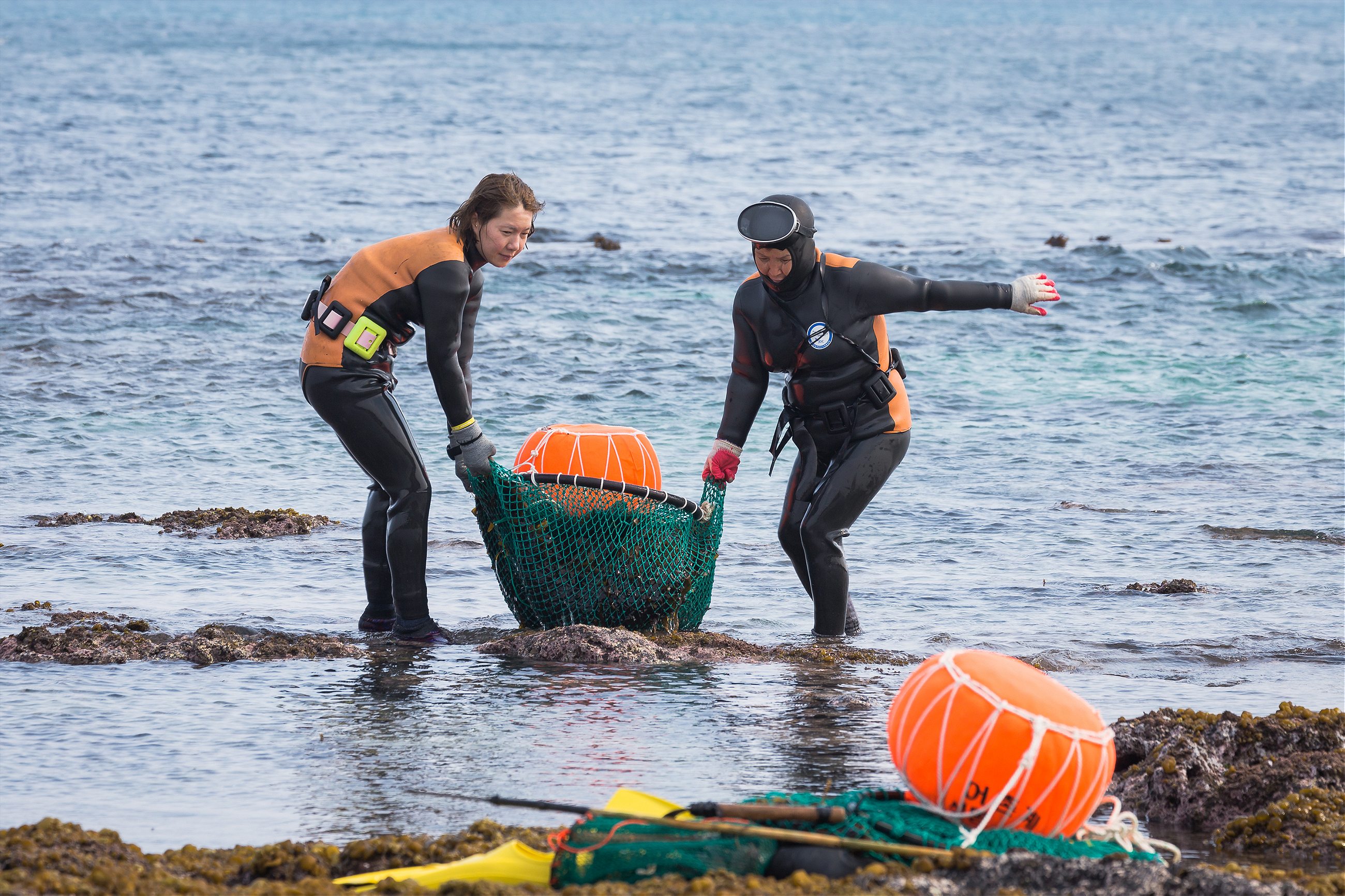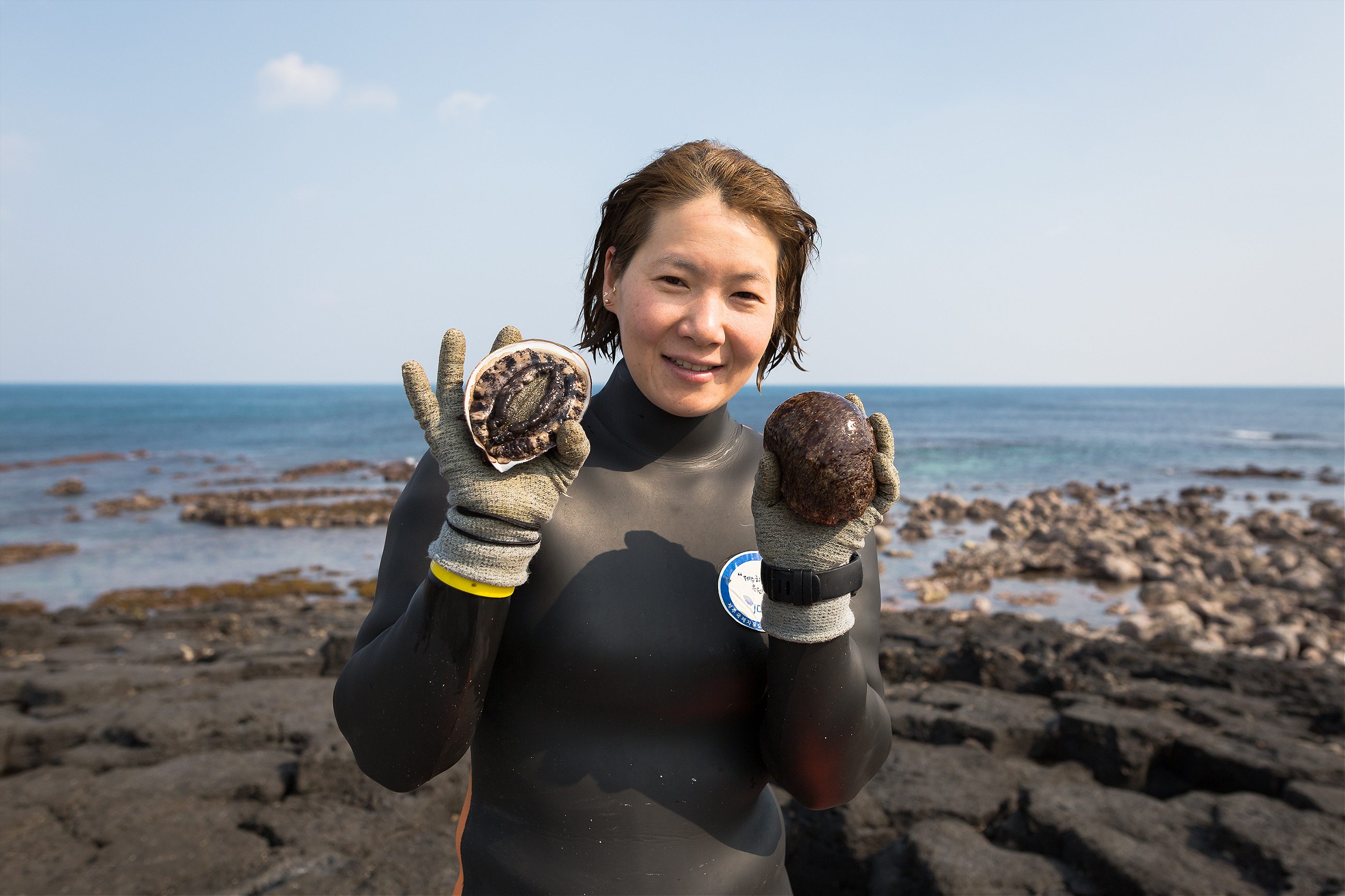Meet the Korean women keeping an ancient seafood tradition alive.
Four years ago, Ji-ae Chae commuted to her job on the Seoul subway. She spent her days cutting, dyeing, and drying hair at a salon. It was an arduous life: she had trouble finding time to care for her children, she was constantly sick, and interacting with indifferent strangers every day left her drained.
Now, like her mother before her, Chae, 33, spends her working days diving into the Korean Strait without an oxygen tank to gather red sea cucumber, urchins, and abalone from the ocean floor.
Chae is a haenyeo, a traditional profession on her home island of Jeju, South Korea. For centuries, these female divers have eked out a living by plunging into the sea to gather its edible treasures and sell them. In the 1960s, at their apex, there were 23,000 haenyeo women on Jeju, according to the island’s Haenyeo Museum. But now, only 4,300 haenyeo remain; many experts believe this generation will be the last, as young people flee to cities and pollution destroys the haenyeo’s place of work: the fragile aquatic ecosystem of the Strait. As of last year, Jeju was home to only 67 haenyeo under the age of 50.
But as the haenyeo’s numbers have dwindled, interest in them has grown. The aforementioned Haenyeo Museum opened in 2006; in 2015, the Jeju government spent the equivalent of $6.5 million USD on preservation measures for the haenyeo, such as subsidizing the cost of their wetsuits and helping pay for their accident and medical insurance; and in 2016, UNESCO awarded the divers a Cultural Heritage of Humanity designation.

No one’s quite sure when Jeju’s inhabitants first started harvesting shellfish from the ocean floor. Archaeologists have found evidence of shellfish-gathering from as far back as 300 B.C.E., while the first historical mention of divers appeared in a court document from 1460. These early haenyeo contributed to a shell trading network with China and Japan. Then, at some point in the 1600s, women started taking over the diving work. This could be because foreign wars drained Jeju’s men away from the island; it could be because women’s earnings were exempt from the onerous taxes imposed by the Korean king in this era. No one knows for sure. But for whatever reason, the haenyeo became exclusively female, a tradition that’s endured until today.
Experts say that today’s increased interest in the haenyeo stems from the fact that haenyeo is not merely a profession, but a way of life that may soon be lost.
“Over the past 15 years or so, the respect for the haenyeo has risen,” says Brenda Paik Sunoo, a Jeju resident and author of the book Moon Tides: Jeju Island Grannies of the Sea. “The [haenyeo’s] legacy is not just economic. It’s social, it’s cultural.”
Chae’s reasons for becoming a haenyeo are certainly a vibrant illustration of haenyeo as a culture, not just a profession. Chae returned to the island because she suspected working beneath the ocean would afford her more freedom, social support, purpose, and work-life balance than laboring in a modern city. Despite the trials and challenges she’s faced, she feels now that she was right.

Jeju is a subtropical island, roughly 700 square miles of volcanic rock and soil off the Korean peninsula’s southern tip. Its center is dominated by a snow-topped volcano, Mount Halla, and along its coasts, cliffs of hexagonal basalt stones jut into the dull turquoise sea. The air is cool but humid, the water tepid. At night, the lights of squid boats glimmer offshore. The island has always maintained its own distinct culture, dialect, and shamanistic traditions, despite centuries of colonization and violence, most notably the Jeju Uprising of 1948, when mainland Korean forces, intent on purging communists from the island, killed tens of thousands of civilians. Throughout it all, as the men of the island fought or languished in prison, the haenyeo remained the island’s economic and cultural bedrock.
These days, Jeju is known for its fishing industry, its yearly mandarin orange crop, and tourism. Todd Thacker, chief manager at the Jeju Tourism Organization, says that although people don’t come to Jeju specifically for the haenyeo, the sight of these divers working up and down Jeju’s shores is a memorable part of the landscape for many visitors. The coastline is dotted with beachside shacks where haenyeo tidily slice into squirming fish’s gills. Outside one shack, live sea cucumbers and conches in their gnarled shells sit in red and turquoise baskets, while fish float in an adjacent tank. An old haenyeo float—white instead of orange—hangs with its net in the corner. Lunch is served at long picnic benches near a heater, and includes a plate of thinly sliced raw whitefish, eaten with thick onions, wasabi, soy sauce, and red chili pepper paste. The second course is MaeUn Tang, a hot fish stew, served on a tabletop gas stove, along with the traditional Korean sides that arrive with all meals: kimchi, radishes, pickled cucumbers.
Every day, a group of haenyeo show off their traditional songs and diving practice for tourists at Sunrise Peak, a green-limned volcanic tuft cone jutting off the island’s eastern coast. Chae lives and dives nearby, in the Samdal region. At work, she wears yellow flippers and a black wetsuit, and carries a turquoise net attached to a bright orange float that looks like a pumpkin. She dives off seaweed-moist basalt rocks into the shallows, then quickly paddles away from shore, her face in the water. On her way out, she dips down every few meters, her flippers graceful in the air as she checks the bottom. In less than a minute, she’s far away, a black rubber hood on the choppy water. After she dives, only her orange float remains, bobbing on the chilly sea.

It’s taken her four years to reach this point. One cannot simply decide to become a haenyeo and jump into the ocean; instead, the traditional haenyeo culture that so defines Jeju relies heavily on both cooperation and hierarchy. In Chae’s village, 13 women currently work as haenyeo, the oldest age 87. These haenyeo are divided into three levels: the bottom level, the hagun, includes beginners and older women, while the top level, sanggun, is comprised of women like Chae’s mother, who can dive into the most difficult and treacherous territory.
To become a haenyeo, Chae had to earn a yes vote from every woman in her village. Everyone approved her—except her mother. Once Chae convinced her mom that she was serious about her ambitions, she started training. It takes a new haenyeo like Chae five years to achieve full competency. At this point, she’s a junggun, the middle level, and can dive 20 feet down and hold her breath for between 40 seconds and a minute. Her mother, as an expert, can reach depths of more than 30 feet.
Chae doesn’t shy away from talking about the difficulties of her new life. The haenyeo export most of their products, especially turban shells to Japan, where they are considered a delicacy. That means, however, that they’re beholden to the vicissitudes of the international seafood market. They can survive through a combination of diving and farming on the side, but their salaries are not what anyone would call luxurious. A haenyeo can dive from sunrise until lunch gathering sea urchins, then spend the rest of the day prying them open. For the whole day’s work, she would typically make about 17,000 yuan, the equivalent of about $17.
It’s not just the low pay for long hours, either. The haenyeo dive six hours a day, approximately 18 days per month, depending on the weather and tide conditions. Chae says she didn’t realize before she became a haenyeo that the women take pills to cope with motion sickness, which is compounded by the stink of their rubber suits and the disorienting fogging of their masks.

Pushing through these conditions, says Chae, takes a certain mindset, the same mindset that has made haenyeo the anchor of Jeju society for centuries. Chae experienced this feeling at the beginning of her career, when she brought home seafood she had harvested to her youngest child, who ate them and said he wanted more. She knew then that she was hooked.
“It’s greedy, but it’s not the bad greedy,” Chae says. “It’s, ‘I want to catch these things more and I want to feed my family.’…If I catch this maybe I can send my kids to academy schools. That’s kind of a woman diver’s thinking.”
But most importantly, haenyeo must be careful not to push too far. Spending so much time beneath the sea, deprived of oxygen, can lead to fatal heart problems. In 2014, nine haenyeo died while diving. “They have to use faith to know when to stop, to have enough breath to come up slowly, to not take too much time to grab that final sea urchin or abalone that’s stuck under the rock,” says Sunoo.
To justify spending so much time in the dangerous ocean, the haenyeo recite an old saying: we make money in the world-after-death while holding our breaths, and if we’re lucky, we come back to our world to spend it.
Sometimes, dolphins try to play with them
One of the many dangers of the haenyeo life is the possibility of allowing their sublime surroundings to distract them while diving. But sometimes, Chae and her fellow haenyeo can’t help themselves, especially when a school of dolphins swims between them. Sometimes, the dolphins try to play with them, which Chae describes as both scary and funny.
The sheer amount of time spent under the sea means that the haenyeo have been first-hand witnesses to the environmental devastation of our oceans. Forget danger, forget fluctuating prices, forget modernization: pollution might be the factor that puts an end to the haenyeo once and for all, says Sunoo.
“Years ago when I started interviewing them, they were already saying that the sea underneath wasn’t blue or green anymore, and that their products were getting destroyed,” she says.
And yet one of the reasons the haenyeo have received so much respect of late is precisely because of their attention to this destructive force. According to the Jeju Haenyeo Museum, the haenyeo prohibit harvests at certain times to preserve the region’s ecology, and they never allow the harvesting of young fish and shellfish. On Chae’s side of the island, the haenyeo have collectively decided to catch sea cucumber in the winter, then switch to urchins from March through May and gather seaweed in summer. They don’t gather conches in August and September or abalone in November and December.
“Abalone eat sea trumpet, a kind of seaweed,” Chae says. “But because of pollution, the seaweed is disappearing, so the abalone is also disappearing.” She adds, “If we can catch the abalone, it’s kind of like winning the lottery.”

Thanks perhaps to their perseverance in the face of such adversity, the haenyeo have developed a certain flinty and prickly reputation. But Chae, a slight, smiley woman who wears a yellow Disney sweatshirt and a bow in her hair when she’s not diving, says that that’s simply not true. In her experience, the haenyeo are not unlike most women, or indeed, like most people: they love spending time with their friends, they care about their families, they feel pain, no matter that they work at a job at which they dive into the cold ocean until they can’t feel their feet.
Most importantly, they look out for Chae. She was right about one thing when she left Seoul: it’s easier to be a single haenyeo mom than a single hairdresser mom. She recalls a time when, new to Jeju, her children were sick and she stopped diving early. When the other divers found out, they gave her extra seafood.
“It’s not only one time. It happens all the time,” she says. “They take care of my kids, it’s very good. My kids are surrounded by their grandmothers.”
She adds, “The women divers are a big community. When I was in Seoul, I didn’t like people. When I became a woman diver, I liked people again.”
After she finishes diving, Chae removes her mask. She shucks her spoils into a big green bowl; she holds a Japanese flatfish up in front of her face, laughing. It may be a difficult life, fraught with dangers, one that might vanish within her lifetime. But for all its flaws, it’s the one she’s chosen—and she doesn’t regret it.
“My friends say, now you look better than when you were working in Seoul,” she says. “They never say that I should use my hairdressing skills. They say, you look good. You found your way.”